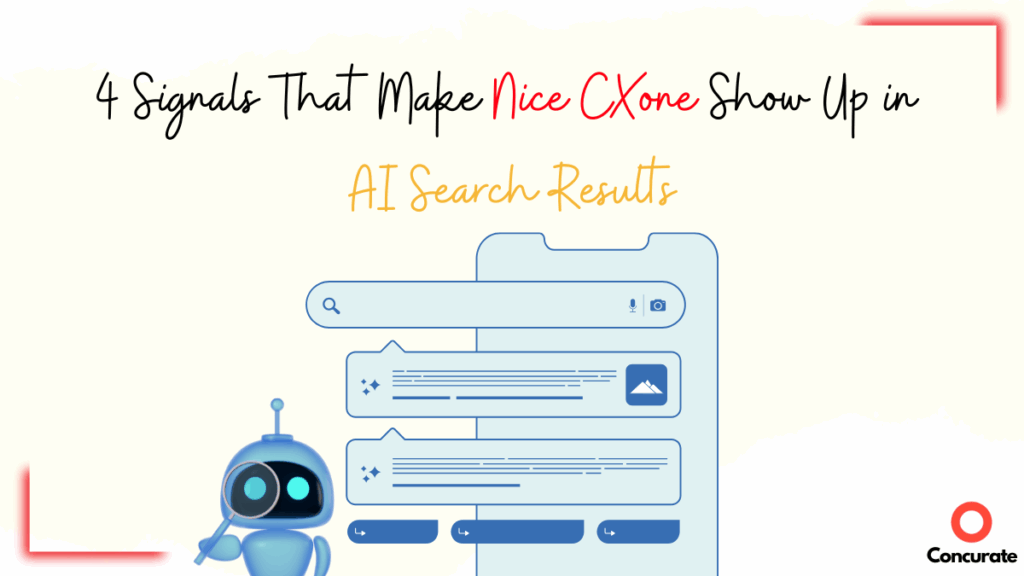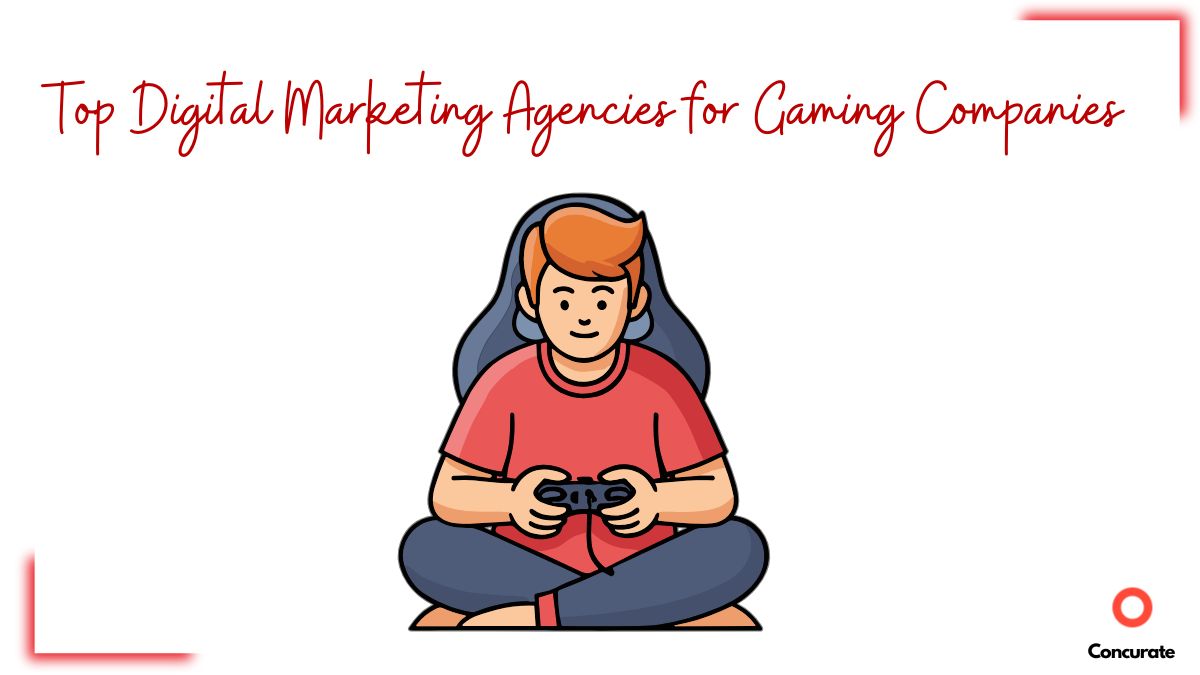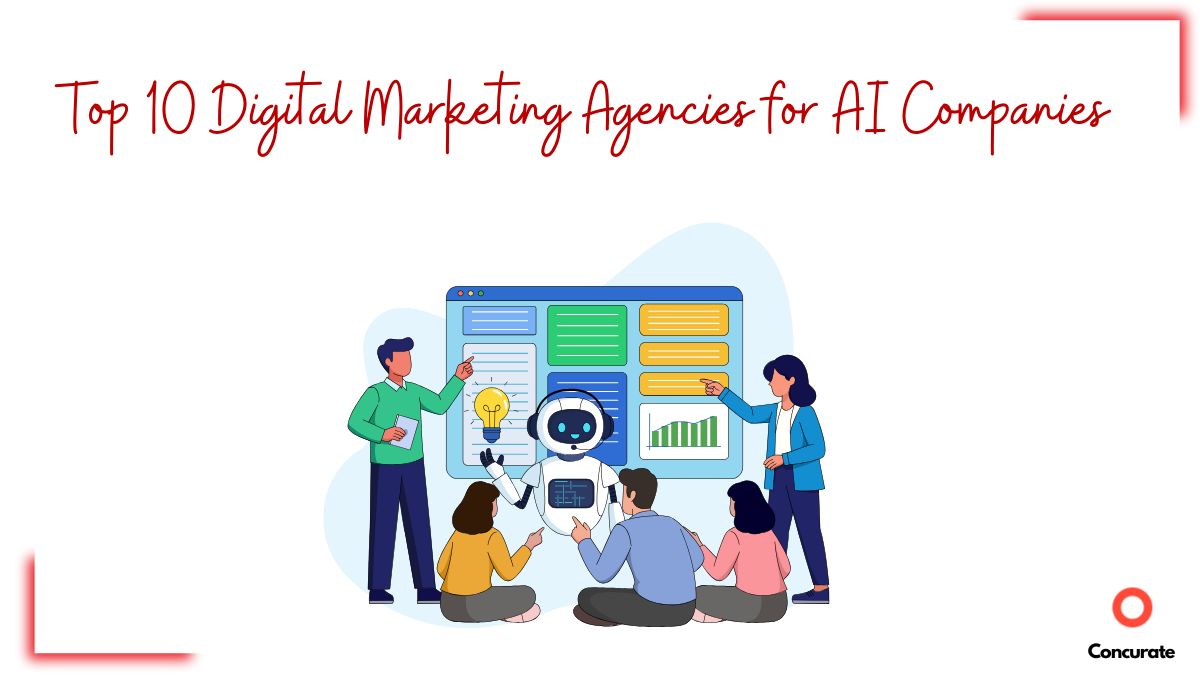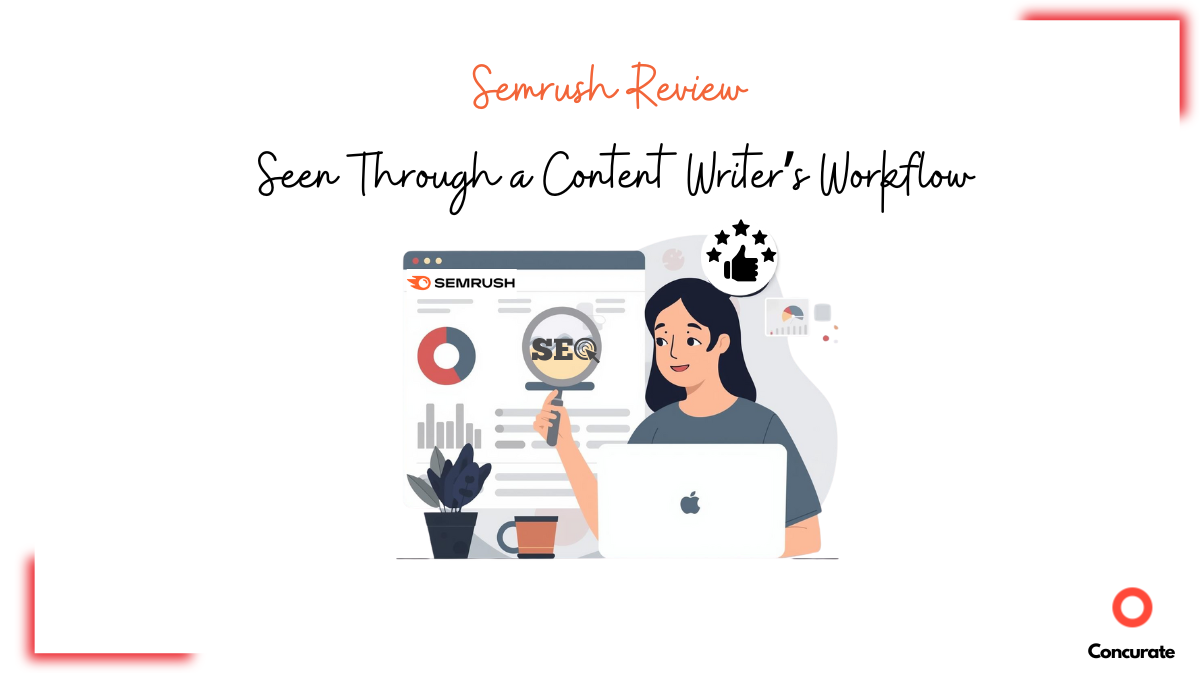| TL;DR: NICE CXone wins AI visibility by owning comparison queries, showing transparent pricing and trust signals, leveraging analyst credibility, and proving ROI with case studies. Founders can replicate this playbook to avoid being invisible in high-intent AI searches. |
Most discussions about contact center platforms sound the same with AI copilots, omnichannel routing, analytics dashboards.
NICE CXone has all of that, but here’s what’s more interesting. When you ask ChatGPT, Perplexity, or Gemini questions like “Genesys vs NICE” or “Best alternatives to Five9”, NICE almost always shows up.
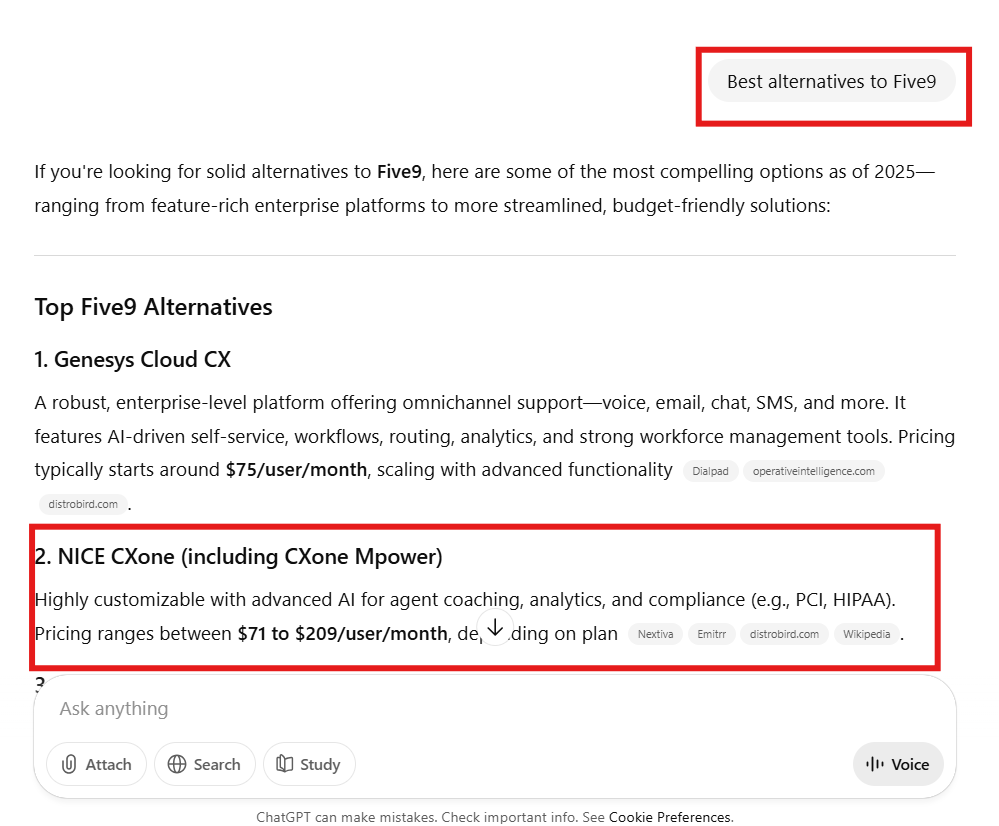
Nice CXone surfaces in ChatGPT’s answer to “best alternatives to Five9”’
In our Genesys AI Visibility Case Study, we showed how Genesys benefits from third-party mentions like analyst reports, competitor blogs and review sites.
We’ve also broken down Zendesk’s AI search visibility to show how different players engineer signals in their own way.
NICE takes a different approach.
Instead of waiting for others to compare them, they publish head-to-head pages themselves, like, NICE vs Genesys, NICE vs Five9, and NICE vs Amazon Connect.
That strategy makes a difference. Buyers searching for comparisons get NICE’s perspective immediately, and AI tools crawling the web get clean, structured content to quote.
The result?
NICE doesn’t just show up in AI answers because of reputation, they show up because they’ve taken control of the narrative.
In this article, we’ll break down:
- The specific signals that make NICE surface in AI search results.
- Proof from live queries showing where they appear.
- A playbook founders can apply to engineer the same visibility for their own SaaS.
Because if buyers are comparing vendors inside AI tools, and your product isn’t part of that conversation, you’re invisible when it matters most.
1. NICE CXone Answers Buyer Comparison Questions Directly
When buyers are close to a decision, their searches change.
It’s no longer “What is CCaaS?”
Instead, it’s queries like“Genesys vs NICE,” “NICE vs Five9” or “NICE vs Amazon Connect.”
Most vendors let competitors or review sites write these comparisons, but NICE doesn’t. They publish the pages themselves.
If you’re wondering how to structure these pages so AI tools actually read and surface them, here’s our guide on optimizing SaaS websites for ChatGPT and Perplexity
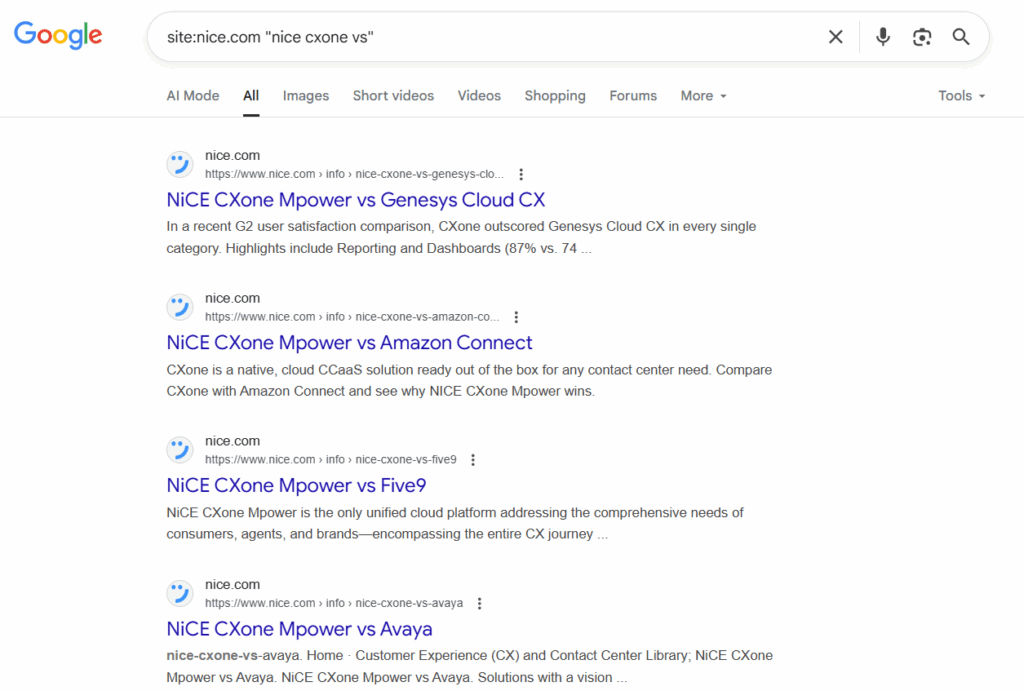
Nice CXone’s competitor pages appearing in google search result for query “nice cxone vs”
This does two things:
- Buyers get clarity right away without hunting through analyst PDFs or biased competitor blogs.
- AI tools get structured content they can easily cite. When ChatGPT gets asked “Genesys vs NICE,” NICE’s own words are right there to use.
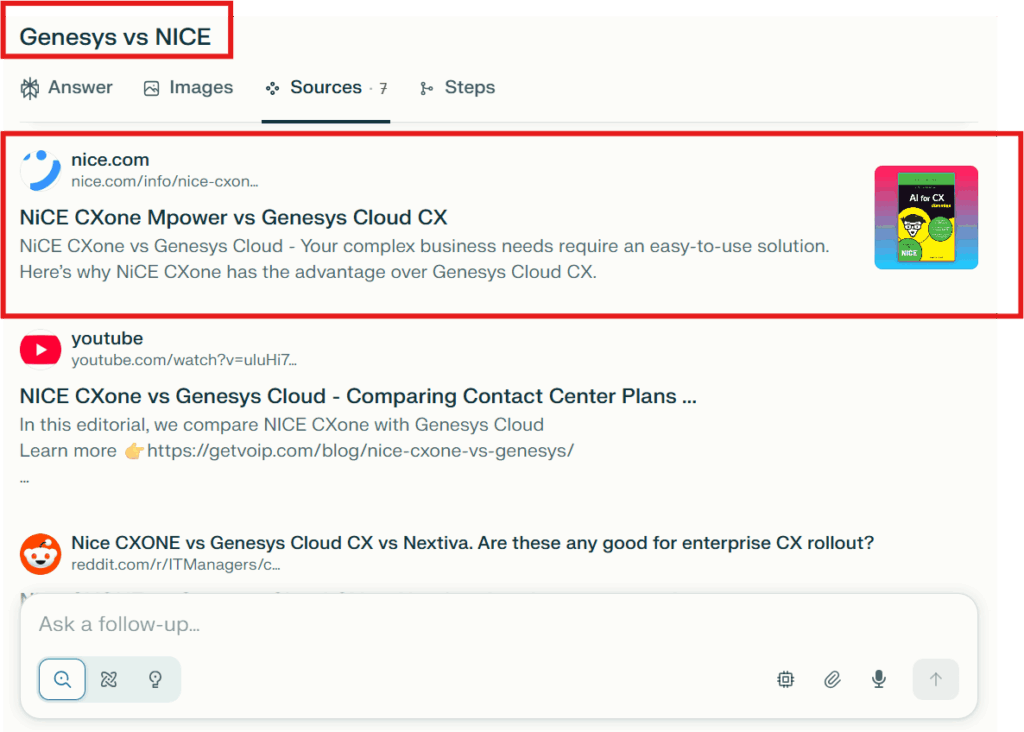
Nice CXone’s competitor page cited as a source in Perplexity when asked “Genesys vs NICE”
Genesys shows up in comparisons because other people talk about them. NICE shows up because they’ve taken control of the conversation.
Another angle in the same space comes from Zendesk, which shows up through ecosystem mentions, trust hubs, and ROI-led proof.
Founder Takeaway:
If buyers are comparing you to competitors, don’t leave it to chance. Write the page yourself. Control the story. Make it easy for both buyers and AI engines to include you.
2. NICE CXone Makes Evaluation Easy
After comparisons, buyers move to evaluation. That’s when the real questions come up.
Questions like “How much does it cost?,” “Can I trust them with sensitive data?,” “Will it scale as we grow?,” and “What results can I expect?”
A lot of vendors bury those answers. Pricing locked behind a sales form. Compliance details hidden in PDFs. Case studies written like PR fluff.
NICE does the opposite.
Their pricing tiers are public. Their Trust Center spells out certifications and shows uptime in real time.
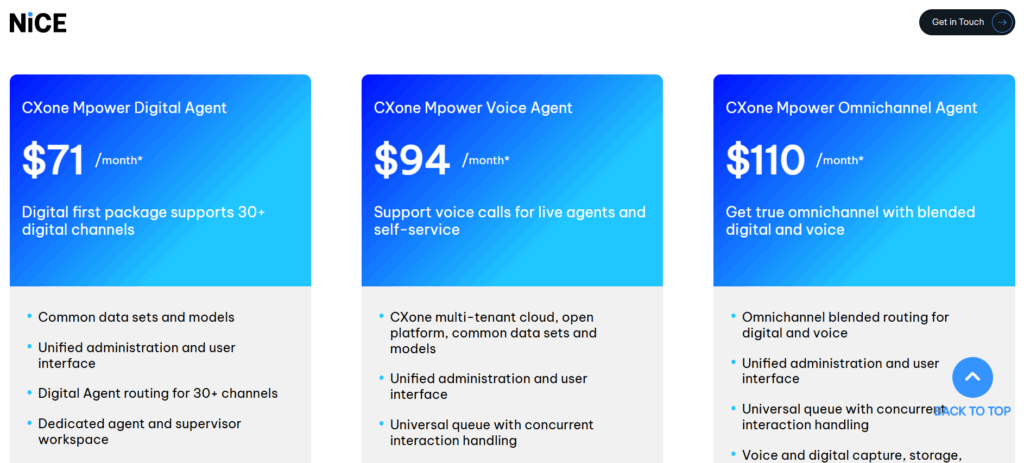
Nice CXone’s pricing page
This kind of transparency also lines up perfectly with newer practices like using LLMs.txt to optimize websites for AI search engines
They highlight billions of interactions handled every year to prove scale. And their case studies talk in numbers, not adjectives.
For buyers, it saves time. For AI tools, it makes NICE the safe choice to recommend, because the signals are obvious and quotable.
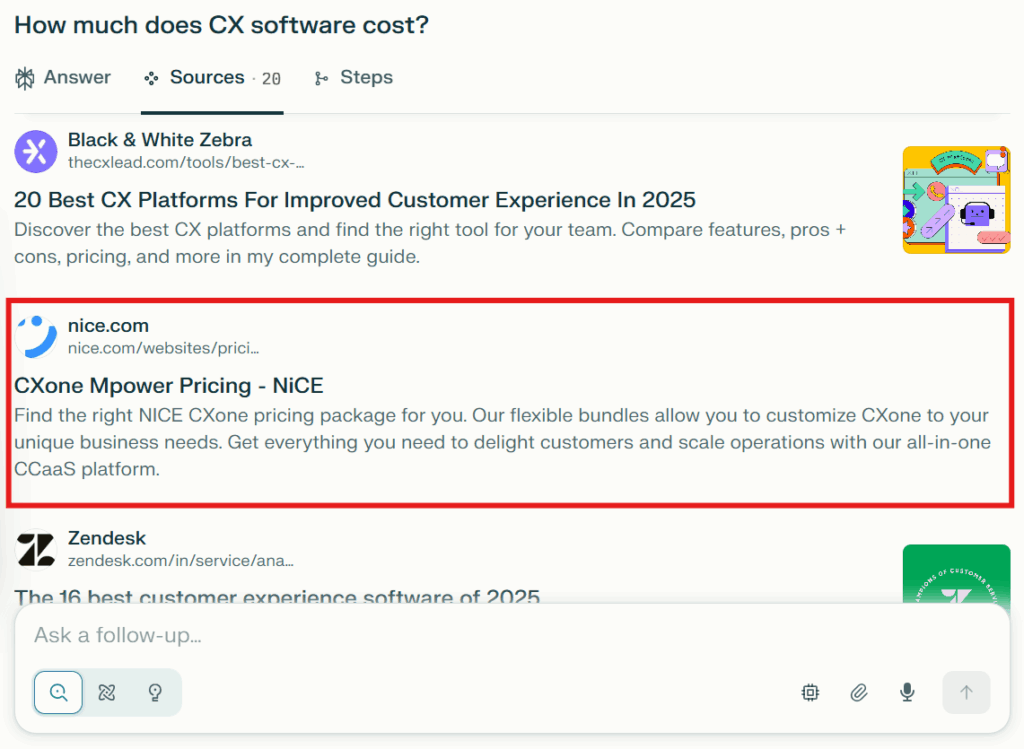
Nice CXone appearing in Perplexity search results for a broad query, “How much does CX software cost?”
Founder Takeaway:
Make evaluation easy. If the basics are hidden, buyers move on. And so do AI crawlers.
Nextiva reinforces the same idea by pairing transparent pricing with fresh buyer-use-case pages.
3. NICE CXone Rides the Analyst and Review Wave
Type “Best CCaaS platforms” into ChatGPT or Perplexity. NICE almost always shows up.
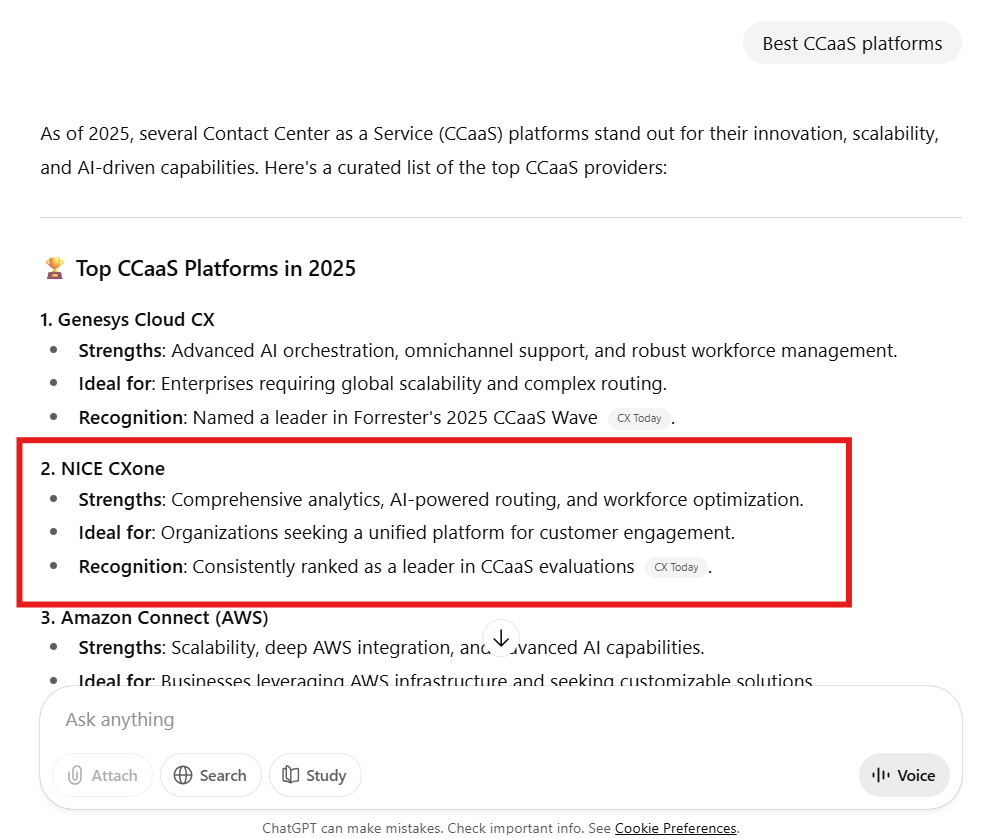
Nice CXone appearing in ChatGPT search results as one of the best CCaaS platforms
Why? Because they’re everywhere analysts and reviewers are. Gartner Magic Quadrant, Forrester Wave, IDC reports, G2 leaderboards, Peer reviews on TrustRadius, you name it.

Nice CXone positioned in the Gartner Magic Quadrant report for 2024
These aren’t one-off mentions. They’re repeated signals across sources buyers already trust. And AI tools trust them too. When they’re looking for safe, credible answers, they lean on what analysts and reviewers have already published.
It’s a powerful flywheel. Analysts cite NICE. Review sites rank NICE. AI engines pull NICE into answers. And buyers see NICE validated at every turn.
If you’re finding these breakdowns useful, you’ll love Newsletter Alpha. Our weekly digest that helps SaaS teams cut through the noise with actionable insights. It’s the shortcut your content team needs.
Founder Takeaway:
You don’t need Gartner tomorrow. But you can build your own version of this. Create mini-analyst assets like, customer surveys, benchmark reports, and product usage insights. Publish them in a way that’s easy to cite. Over time, those signals work the same way.
4. NICE CXone Frames the Story in Outcomes Through Case Studies
Most vendors still lead with features like omnichannel routing, AI assistants and advanced dashboards.
But buyers don’t ask, “Which platform has the best routing?”
They ask, “Which platform reduces handle time?” Or, “Which CCaaS delivers better ROI?”
NICE has an answer because they publish case studies packed with numbers, real clients, real impact, reduced handle times, higher CSAT and improved agent productivity.
That’s what makes them quotable. Buyers remember numbers. AI tools surface numbers. And NICE gives both audiences exactly what they need.

Nice CXone appearing in ChatGPT search results when asked about reduced handle time
We’ve detailed what makes a strong SaaS case study in our guide to B2B SaaS case study best practices.
Case studies aren’t just proof, they’re visibility assets. The more specific the outcomes, the easier it is for both a prospect and ChatGPT to say, “NICE improves X metric.”
And if you want those case studies to actually get seen, not just published, you’ll want a distribution plan like the one we outlined in how to promote and distribute B2B SaaS case studies.
Founder Takeaway:
Don’t let your case studies gather dust in PDFs. Put them online, make the numbers impossible to miss, and use them to frame your story in outcomes, not features. That’s how you earn credibility with buyers and show up in AI answers.
What Founders Can Take Away
NICE CXone shows up in AI answers because they’ve built the right signals:
- They publish comparison pages so buyers don’t have to rely on competitors to tell the story.
- They make evaluation questions like pricing, trust, compliance, and scale, easy to answer.
- They ride the analyst and review wave, showing up wherever credibility is earned.
- They frame their story in outcomes through case studies, not just features.
For founders, the lesson is clear. You don’t need NICE’s brand power or Gartner coverage to start. You need to put the right proof in the right places.
That means:
- Own the buyer-intent queries with your own comparison content.
- Make the basics (pricing, trust, scale) one click away.
- Publish case studies that put numbers front and center.
- Package customer data into analyst-style reports buyers and AI tools can cite.
If you’re wondering how to turn these lessons into action, we’ve built a 13-point checklist to optimize B2B SaaS blogs for AI search. It’s the exact framework we use to help SaaS teams show up in ChatGPT and Perplexity answers.
Our Generative Engine Optimization services are designed to help SaaS founders put these signals in place deliberately, not by chance.
That means publishing the comparison content buyers are already searching for, building trust pages that answer the tough questions upfront, and turning case studies into real visibility assets instead of PDFs that never get seen.
The goal isn’t just traffic. It’s to make sure your brand shows up in the exact AI answers and buyer conversations where purchase decisions are made.
If you’d like to see how this playbook could work for your SaaS, book a call with us and let’s design it together.
FAQs
Because NICE publishes direct comparison pages (e.g., “NICE vs Genesys”), answers evaluation questions like pricing and compliance clearly, and backs up claims with case studies full of outcomes. These signals make it easy for both buyers and AI tools to reference them.
RingCentral takes a slightly different path, anchoring itself as the AI communications leader while also publishing deep comparison pages.
Absolutely. You don’t need Gartner mentions or enterprise budgets to show up in AI answers. By publishing your own “alternatives” and “vs” pages, making trust signals visible, and turning customer results into case studies, you can start surfacing in the same way.
Case studies turn vague feature claims into measurable proofs like reduced handle time, higher ROI, and improved CSAT. AI tools pull these numbers into answers, and buyers trust them more than adjectives. That’s why making case studies easy to find (not hidden PDFs) is a visibility advantage.
It varies. Some update in weeks, others in months. But the earlier you publish comparison content, case studies, and trust pages, the sooner you’ll start seeing your brand appear in queries.
Focus on one bottom-funnel asset first. It’s usually a comparison page against your closest competitor or a case study that proves outcomes with numbers. From there, layer in trust pages and category roundups. Concurate’s Generative Engine Optimization services are designed to help founders prioritize and execute these steps in the right order.
The simplest way is to run the same queries your buyers would: “[Competitor] alternatives,” “[YourCategory] best tools,” or “[Competitor] vs [YourProduct].” If AI tools never mention you, that’s a signal your brand’s digital footprint is too thin. At Concurate, we built a framework for auditing AI visibility so founders can see exactly where they show up today and where new signals need to be planted.


